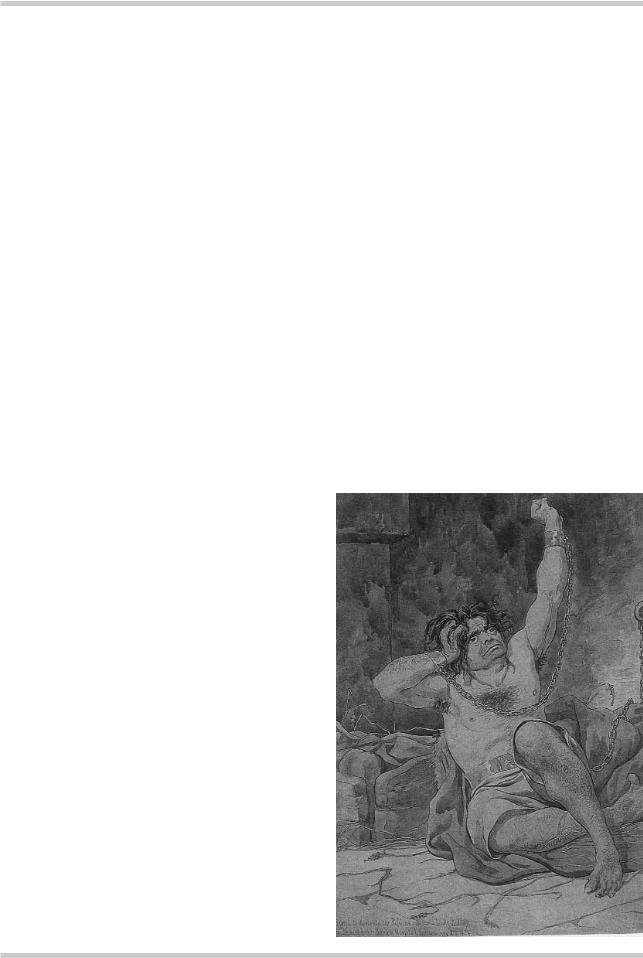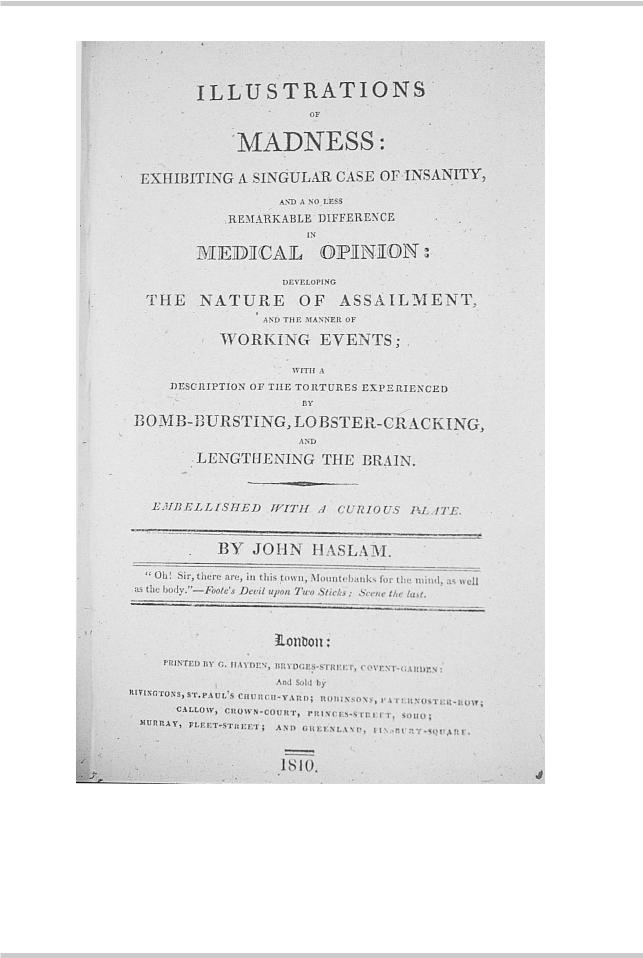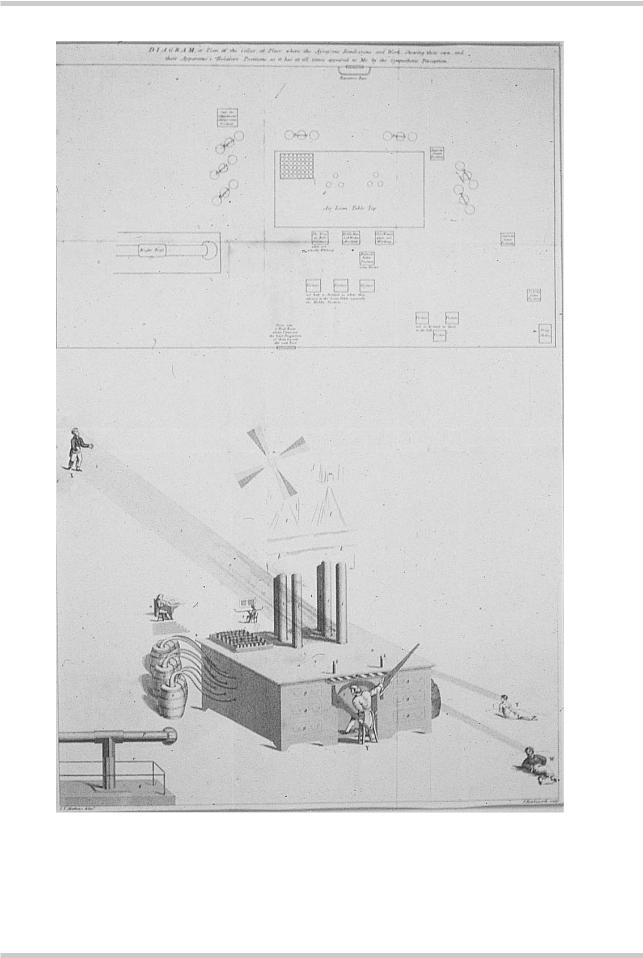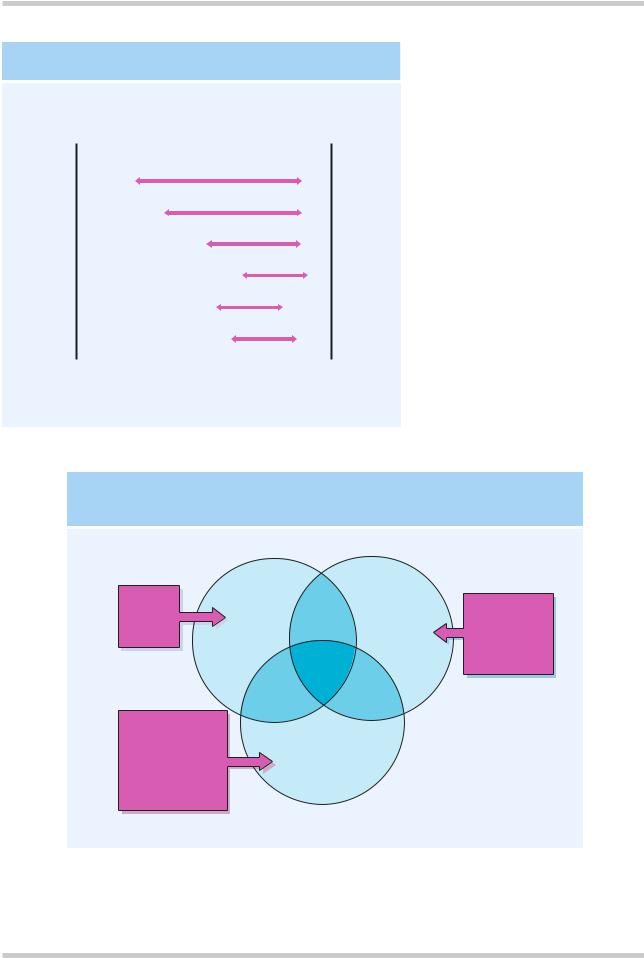
- •Contents
- •Other atlases in this series include:
- •Preface
- •Foreword
- •History and Classification
- •The Acute Illness
- •The Chronic Illness
- •Factors Affecting Prognosis
- •References
- •Genetics
- •Environmental Influences
- •Early Environmental Factors
- •Obstetric Complications
- •Prenatal Infection
- •Neurodevelopmental Abnormality
- •Later environmental factors
- •Substance Misuse
- •Social and Psychological Factors
- •Conclusion
- •References
- •Structural Imaging and Anatomical Studies
- •Functional Brain Imaging
- •Neurochemistry
- •Neuropsychology
- •Psychophysiology
- •References
- •Introduction
- •Classification of Antipsychotics
- •Neurochemistry of Schizophrenia and Mechanisms of Action of Antipsychotics
- •Dopamine
- •Serotonin
- •Other Neurotransmitters
- •Efficacy of Antipsychotics in the Acute Phase of Treatment
- •Pharmacotherapy as Maintenance Treatment in Schizophrenia
- •Low-Dose Antipsychotics
- •Intermittent or Targeted Medication
- •Acute Neurological Side-Effects
- •Medium-Term Neurological Side-Effects
- •Chronic Neurological Side-Effects
- •Neuroendocrine Effects
- •Idiosyncratic Effects
- •Cardiac Conduction Effects of Antipsychotics
- •Clozapine
- •Risperidone
- •Olanzapine
- •Quetiapine
- •Amisulpride
- •Ziprasidone
- •New Antipsychotics Currently in Phase III Clinical Trials
- •Iloperidone
- •Aripiprazole
- •Negative Symptoms
- •Cognition
- •Affective Symptoms
- •The Future
- •References
- •Psychological Therapies
- •Cognitive Behavioral Therapy
- •Neurocognitive Remediation
- •Compliance with Drug Treatment
- •Family Treatments
- •Early Intervention
- •Managing Schizophrenia in the Community
- •References

CHAPTER 1
Clinical features
HISTORY AND CLASSIFICATION
Schizophrenia is arguably the most severe of the psychiatric disorders. It carries a lifetime risk of around 0.5–1%, and its early onset and tendency to chronicity mean that its prevalence is relatively high. Disability results particularly from negative symptoms and cognitive deficits, features that can have a greater impact on long-term functioning than the more dramatic delusions and hallucinations which often characterize relapses. The social and economic impact of the illness is enormous, and its impact on sufferers and their families can be devastating.
Although descriptions of people who may have had schizophrenia-like illnesses can be found throughout history (Figure 1.1) the first
Figure 1.1 Sketch to Illustrate the Passions: Agony – Raving Madness, by Richard Dadd (1854). In this painting, Richard Dadd (1817–1886) alludes to a pre-Kraeplinian distinction between ‘raving madness’ and ‘melancholic madness’. Dadd himself was a patient at the Bethlem (Bedlam) Hospital, England’s oldest mental hospital, and at Broadmoor, the hospital for the criminally insane. A Victorian painter best known for his fairy paintings, Dadd developed his illness at around the age of 25, when he become suspicious and preoccupied with religion, and developed delusions relating to the Egyptian god Assyris, beliefs that thoughts and commands which he had to obey were put into his head, and delusions that he was persecuted by the devil. At the age of 27, in response to these beliefs, he attacked and killed his father. He spent the rest of his life in institutional psychiatric care. Figure reproduced with kind permission of the Bethlem Royal Hospital Archives and Museum, Beckenham, Kent, UK
comprehensive descriptions date from the beginning of the 18th century (Figures 1.2 and 1.3)1. The modern concept of schizophrenia was first formalized by the German psychiatrist Emil Kraepelin (Figure 1.4)2,3 at the turn of the 20th century. Kraepelin, who drew on contemporary accounts of syndromes such as catatonia and hebephrenia, was the first to distinguish between
©2002 CRC Press LLC

Figure 1.2 Frontispiece from Illustrations of Madness (1810), by John Haslam1, which provides a vivid description of psychosis in an individual patient early in the industrial revolution. James Tilley Matthews was admitted to the Bethlem Hospital in 1797, after writing a threatening letter to a senior official in the British Admiralty. Haslam, who was Matthews’ doctor at the Bethlem, wrote his book as a rebuttal of claims made in court that Matthews was not insane. Matthews believed that a ‘gang of villains, profoundly skilled in pneumatic chemistry’ were assailing him: ‘while one of these villains is sucking out the brain of the person assailed, to extract his existing sentiments, another of the gang will force into his mind a train of ideas very different from the real subject of his thoughts’. He experienced many other unpleasant experiences, including ‘sudden death squeezing, stomach skinning, apoplexy making with the nutmeg grater, lengthening of the brain, thought making and laugh making’. Figure reproduced with kind permission of the Bethlem Royal Hospital Archives and Museum, Beckenham, Kent, UK
©2002 CRC Press LLC

Figure 1.3 Air-loom, by James Tilley Matthews, circa 1810. This plate is included in Haslam’s book1. It is Matthews’ own ‘diagram or plan of the cellar or place where the assassins rendezvous and work, showing their own and their apparatuses’ relative positions, as it has at all times appeared to me by the sympathetic perception’. As well as the ‘air-loom’, Matthews indicates the sources of various abnormal experiences: the voices of the King, Bill, the Middle Man, the Glove Woman, Augusta, Charlotte, St Archy, and assorted visitors, who are ‘not half so distinct as when they advance to the Loom Table, especially the Middle Position’, together with a ‘door into a back room where I have not the least perception of them beyond the said door’. Figure reproduced with kind permission of the Bethlem Royal Hospital Archives and Museum, Beckenham, Kent, UK
©2002 CRC Press LLC

Figure 1.4 Emil Kraepelin (1856–1926). The fifth edition of Kraepelin’s Textbook of Psychiatry2, published in 1896, articulated a distinction between acquired and constitutional pathology in mental illness. The sixth edition, published in 1899, distinguished between dementia praecox and manic depressive insanity
Figure 1.5 Eugen Bleuler (1857–1939). In 1911, Eugen Bleuler published his monograph entitled Dementia Praecox, or the Group of Schizophrenias, and argued that dementia praecox was not a single disease, was not inevitably associated with intellectual decline, and had as its fundamental basis disorders of affectivity, ambivalence, autism, attention and will. Other symptoms such as delusions, hallucinations, abnormal behavior and catatonia were conceptualized as secondary ‘accessory symptoms’
the two major poles of severe mental illness. He described one group of patients in whom the clinical picture was dominated by disordered mood and who followed a cyclical pattern of relapse and relative remission; he termed this ‘manic depressive insanity’. Others had a deteriorating illness characterized by florid onset, often in adolescence, with a prolonged course marked by profound social and functional disability. He called the latter ‘dementia praecox’, and saw it as ‘a single morbid process’, endogenous rather than acquired, starting in youth and with dementia as a common outcome. This concept has since been enormously influential in guiding our perception of the disorder, even though Kraepelin himself came to recognize many of its limitations: for example, the disease was not always confined to younger people, the progression to dementia was not inevitable and in some individuals a recovery would be seen4.
The Swiss psychiatrist Eugen Bleuler (Figure 1.5) coined the term ‘schizophrenia’ in 1911 and this rapidly displaced dementia praecox5. Unlike Kraepelin, who was strongly influenced by the successes of clinical pathology in the search for causative agents in diseases such as syphilis and tuberculosis, Bleuler thought of schizophrenia in psychological rather than neuropathological terms. For Bleuler, the florid but highly variable symptoms of psychosis, such as delusions and hallucinations, were secondary, ‘accessory’ phenomena. At the core of the illness, he believed, was a more generalized psychological deficit, characterised by a ‘loosening of associations’ in the form of language, by deficits in volition and attention, and by incongruity of affect, ambivalence and autism.
Although intellectually compelling as a model of schizophrenia, Bleuler’s core symptoms were difficult to define reliably. In particular, the limits
©2002 CRC Press LLC

Figure 1.6 Kurt Schneider. In 1959 he listed the 'first rank features' of schizophrenia. One of these symptoms, in the absence of organic disease, persistent affective disorder, or drug intoxication, was sufficient for a diagnosis of schizophrenia
SCHNEIDER’S SYMPTOMS
OF THE FIRST RANK
•Audible thoughts
•Voices heard arguing
•Voices heard commenting on one’s actions
•The experience of influences playing on the body
•Thought withdrawal and other interferences with thought
•Diffusion of thought
•Delusional perception
•Feelings, impulses and volitional acts experienced as the work or influence of
others
of ‘simple schizophrenia’ (schizophrenia uncomplicated by ‘accessory’ symptoms) and ‘latent schizophrenia’ (people with odd personalities said to share some of the characteristics of the fullblown disorder) were difficult to define. This confusion was compounded by the clinical heterogeneity of schizophrenia, the lack of clear prognostic features and the failure to discover any definitive pathological abnormalities, and led to an expansion of the concept of schizophrenia to the extent that it became a vague synonym for severe mental illness with different meanings in different countries. This was especially the case in the USA, where Bleuler’s concepts held great sway, and in the former Soviet Union, where different models (incorporating, for example, anorexia nervosa sufferers and political dissenters) had developed.
In Western Europe, where the Kraeplinian formulation remained dominant, diagnosis was more consistent, partly because the positive psychotic symptoms central to the Kraeplinian definition are more readily and reliably determined. In 19596, Kurt Schneider (Figure 1.6) set out a list of such symptoms, which would be most likely, in the absence of organic brain disease, to
lead to the diagnosis of schizophrenia. These ‘symptoms of the first rank’ were selected because they were relatively easily elicited and reliably identified, rather than because of any central theoretical importance; nevertheless, they were highly influential in determining diagnostic practice.
The International Pilot Study of Schizophrenia7 (IPSS; Figure 1.7) which investigated the illness in several centers around the world, suggested a high degree of consistency in the clinical picture of schizophrenia when diagnosed using strict diagnostic rules. This appeared to hold true in rural and in urban areas, and both in Western European countries and in developing countries. The use of operationalized diagnostic rules in this, and in the earlier US/UK Diagnostic Project, greatly facilitated research into the epidemiology of the disorder. Since then, as a result of the development and use of operationalized definitions in the Diagnostic and Statistical Manual8 of Mental Disorders (DSM–IV) in the USA, and the International Classification of Diseases9 (ICD–10) worldwide, definitions of schizophrenia have been considerably narrowed.
©2002 CRC Press LLC

GEOGRAPHICAL VARIATIONS IN INCIDENCE
(a) Broad definition
Aarhus
Chandigarh
rural
Chandigarh
urban
Dublin
Honolulu
Moscow
Nagasaki
Nottingham
0 |
10 |
20 |
30 |
40 |
50 |
Incidence (per 100 000)
(b) Restrictive definition
Aarhus
Chandigarh
rural
Chandigarh
urban
Dublin
Honolulu
Moscow
Nagasaki
Nottingham
0 |
10 |
20 |
30 |
40 |
50 |
Incidence (per 100 000)
Figure 1.7 Geographical variations in the incidence of schizophrenia, (a) broadly defined and
(b) narrowly defined. These data from the International Pilot Study of Schizophrenia7 were taken as evidence that, particularly when narrow operational criteria are used, the incidence of schizophrenia is remarkably constant between countries. Although this was very influential when it was published, subsequent studies have demonstrated that the incidence does indeed vary, with higher rates found in those born or brought up in cities and in certain immigrant groups
Although diagnosis still depends on the presence of combinations of symptoms and the course of illness, and diagnostic practice may vary to some extent from country to country, there is a core group of patients who fulfill all definitions and would be diagnosed as suffering from schizophrenia anywhere in the world (Figure 1.8).
Both ICD–10 and DSM–IV identify a number of subtypes of schizophrenia. In clinical practice, a distinction is also often made between acute and chronic schizophrenia. A third way of thinking about the varied clinical picture seen in schizophrenia is in terms of syndromes (Figure 1.9). Unlike subtypes, syndromes do not
©2002 CRC Press LLC

THE SPECTRUM OF PSYCHOSIS
|
Affective |
Non-affective |
|
|
psychosis |
psychosis |
|
||
|
|
|
||
|
schizoaffective and non-affective psychosis |
|
|
|
|
|
Non-affective psychosis |
|
|
Excess |
|
ICD schizophrenia |
|
Excess |
|
|
|
||
women |
|
DSM–III schizophrenia |
men |
|
|
|
DSM–III–R schizophrenia |
|
|
|
|
DSM–IV schizophrenia |
|
|
|
|
|
|
|
|
Good |
Poor |
|
|
outcome |
outcome |
|
||
Figure 1.8 Despite the advent of a variety of operational definitions, categorical definitions of schizophrenia vary in their cut-off points on a theoretical continuum. However, there is substantial overlap between diagnostic systems and a significant proportion of patients fulfil criteria in all systems
SYNDROMES OF SCHIZOPHRENIA
Positive |
|
|
Delusions |
|
thought |
|
Reality |
||
|
Hallucinations |
|||
disorder |
Disorganization |
|||
distortion |
Passivity |
|||
|
||||
|
|
|
phenomena |
Social withdrawal |
Negative |
|
Apathy |
||
|
||
Self-neglect |
|
|
Negative thought |
|
|
disorder |
|
Figure 1.9 Symptoms of schizophrenia appear to cluster into three syndromes: ‘positive’, or reality distortion, characterized by delusions and hallucinations; ‘negative’, consisting of the ‘deficit’ symptoms including ‘negative thought disorder’, such as poverty of speech and poverty of content of speech; and ‘disorganization’, in which ‘positive’ formal thought disorder, for example knight’s move thinking or loosening of associations are seen
©2002 CRC Press LLC

represent exclusive domains; any individual patient may have features of more than one syndrome. Initial syndromal studies distinguished between positive and negative symptoms, but more recent work using factor-analytic studies of associations between symptoms supports the existence of a third syndrome, characterized by positive thought disorder or ‘disorganization’. Thus, most clinicians would recognize the existence of psychotic symptom clusters in the following three domains:
1.Delusions and hallucinations, the so-called ‘positive’ symptoms.
2.Positive thought disorder or ‘disorganization’.
3.Social withdrawal, apathy, self-neglect, poverty of speech and of content of speech, and other broadly ‘negative’ symptoms.
CLINICAL PRESENTATION AND
SYMPTOMATOLOGY
As in the rest of medicine, reliable diagnosis depends on accurate history taking and clinical
examination. The family and personal history may offer important etiological clues. There may be a family history of schizophrenia, complications in pregnancy or birth, or a personal history of childhood problems. Recent studies, including the follow-up of the British 1946 birth cohort10, have suggested that children who later develop schizophrenia are more likely to have a history of developmental delay, as well as slightly lower IQ and educational achievements than other children (Figure 1.10). They are also more likely to have interpersonal and behavioral difficulties. Mothers may describe their premorbid personality as having shown emotional detachment; ‘preschizophrenic’ children may appear cold and aloof, avoiding play and engaging in solitary occupations. Some may be prone to temper tantrums, tend to avoid competition, have odd ideas and seek refuge in fantasy. These characteristics are also over-represented in the families of schizophrenics, although they do not reliably predict the development of schizophrenia.
FOLLOW-UP OF THE UK 1946 BIRTH COHORT
birth |
16 years |
43 years |
Speech defects |
Solitary |
Delayed motor milestones
Schizophrenia
Social (n = 30) anxiety
Cognitive
decrement
Figure 1.10 Differences between children destined to develop schizophrenia as adults and the general population were found across a range of developmental domains. As with some other adult illnesses, the origins of schizophrenia may be found in early life. This figure illustrates the associations between adult-onset schizophrenia and childhood sociodemographic, neurodevelopmental, cognitive, and behavioral factors in a cohort of 5362 people born in one week in 1946. Thirty cases of schizophrenia arose between ages 16 and 43 years. Data with permission from Jones P, Rodgers B, Murray R, et al. Child development risk factors for adult schizophrenia in the British 1946 birth cohort. Lancet 1994;344:1398–1402
©2002 CRC Press LLC

DIFFERENTIAL DIAGNOSIS OF
SCHIZOPHRENIA
‘Functional’
Schizotypal disorder
Persistent delusional disorders
Acute and transient psychotic disorders
Schizoaffective disorders
Induced delusional disorder
Mania
Other nonorganic psychotic disorders
‘Organic’
Drug/substance-induced psychosis (e.g. alcohol withdrawal, amphetamines, crack cocaine, LSD, cannabis, PCP, and also steroids, dopamine agonists and some heavy metals)
Epilepsy – in particular, the fits of temporal lobe epilepsy may resemble an acute psychotic episode
Tumors, either primary or secondary
Stroke
Early dementia
Long-term sequelae of head injury
Endocrine causes (e.g. Cushing’s disease; rarely hyperand hypothyroidism)
Infections (e.g. encephalitis, meningitis, neurosyphilis)
Multiple sclerosis
Autoimmune disorders such as systemic lupus erythematosus (SLE)
Metabolic disorders (e.g. hepatic failure, uremia, hypercalcemia, acute intermittent porphyria)
HALLUCINATIONS
Hallucinations are defined as false perceptions in the absence of a real external stimulus. They are perceived as having the same quality as real perceptions and are not usually subject to conscious manipulation.
Hallucinations in schizophrenia may involve any of the sensory modalities. The most common are auditory hallucinations in the form of voices, which occur in 60–70% of patients diagnosed with schizophrenia. Although voices in the second person are most common, the characteristic ‘Schneiderian’ voices are in the third person and provide a running commentary on the patient’s actions, arguing about the patient or repeating the patient’s thoughts. Voices may be imperative, ordering the patient to harm himself or others. Visual hallucinations occur in about 10% of patients, but should make one suspicious of an organic disorder. Olfactory hallucinations are more common in temporal lobe epilepsy than schizophrenia, and tactile hallucinations are probably experienced more frequently than is reported by patients.
No single type of hallucination is specific to schizophrenia, and the duration and intensity are probably most important diagnostically.
©2002 CRC Press LLC

CATATONIC SYMPTOMS
These mainly motor symptoms may occur in any form of schizophrenia but are particularly associated with the catatonic subtype
Ambitendence Alternation between opposite movements.
Echopraxia Automatic imitation of another person’s movements even when asked not to.
Stereotypies Repeated regular fixed parts of movement (or speech) that are not goal directed, e.g. moving the arm backwards and outwards repeatedly while saying ‘but not for me’.
Negativism Motiveless resistance to instructions and attempts to be moved, or doing the opposite of what is asked.
Posturing Adoption of inappropriate or bizarre bodily posture continuously for a substantial period of time.
Waxy flexibility The patient’s limbs can be ‘molded’ into a position and remain fixed for long periods of time.
THOUGHT DISORDERS |
|
DISORDERS OF THOUGHT POSSESSION |
|
|
|
|
|
|
Usually a disorder of the form of thought, such that the speech is difficult to follow or incoherent and follows no logical sequence.
Knight’s move thinking (or derailment) occurs when the patient moves from one train of thought to another which has no apparent connection to the first – it takes its name from the chess piece that moves two steps forward and one to the side. A less severe form is called loosening of associations which merges into tangential thinking and loss of goal.
Some patients may invent neologisms (new words), exhibit verbal stereotypy (repetition of a single word or phrase out of context), or use metonyms (ordinary words given a special personal meaning).
Negative thought disorder includes poverty of speech (limited quantity of speech), and poverty of content of speech (limited meaning conveyed by speech).
Disorders of thought possession in schizophrenia are sometimes called thought alienation. The patient has the experience that his thoughts are under the control of an outside agency or that others are participating in his thinking.
Thought insertion The patient believes that thoughts that are not his own are being put into his mind by an external agency.
Thought withdrawal The patient believes that thoughts are being removed from his mind by an external agency.
Thought broadcasting The patient believes that his thoughts are being ‘read’ by others, as if they were being broadcast.
Thought blocking Involves a sudden interruption of the train of thought, before it is completed, leaving a ‘blank’. The patient suddenly stops talking and cannot recall what he has been saying or thinking.
©2002 CRC Press LLC

DELUSIONS
A delusion is a fixed, false personal belief held with absolute conviction despite all evidence to the contrary. The belief is outside the person’s normal culture or subculture and dominates their viewpoint and behavior.
Delusions may be described in terms of their content (e.g. delusions of persecution or grandeur). They can be mood congruent (the content of delusion is appropriate to the mood of the patient), or mood incongruent. Delusions are described as systematized if they are united by a single theme.
A primary delusion arises fully formed without any discernible connection with previous events (also called autochthonous delusions), e.g. “I woke up and knew that my daughter was the spawn of Satan and should die so that my son could be the new Messiah”.
Secondary delusions can be understood in terms of other psychopathology, for example hallucinations: “The neighbors must have connected all the telephones in the building; that’s why I can hear them all the time”.
The term delusional mood is slightly confusing in that it does not describe an abnormal belief, but refers to an ill-defined feeling that something strange and threatening is happening which may manifest as perplexity, uncertainty or anxiety. This may precede a primary delusion or a delusional perception, which involves a real perception occurring almost simultaneously with a delusional misinterpretation of that perception, e.g. “I saw the traffic lights change from red to green and knew that I was the rightful heir to the throne of England”.
Overvalued ideas are unreasonable and sustained intense preoccupations maintained with a strong emotional investment but less than delusional intensity. The idea or belief held is demonstrably false and not usually held by persons from the same subculture.
Delusions may be classified in terms of their
content, for example delusions of...
Persecution An outside person or force is in some way interfering with the sufferer’s life or wishes them harm, e.g. “The people upstairs are watching me by using satellites and have poisoned my food”.
Reference The behavior of others, objects, or broadcasts on the television and radio have a special meaning or refer directly to the person, e.g. “A parcel came from Sun Alliance and the radio said that ‘the son of man is here’, on a Sunday, so I am the son of God”.
Control The sensation of being the passive recipient of some controlling or interfering agent that is alien and external. This agent can control thoughts, feeling and actions (passivity experiences), e.g. “I feel as if my face is being pulled upwards and something is making me laugh when I’m sad”.
Grandeur Exaggerated belief of one’s own power or importance, e.g. “I can lift mountains by moving my hands, I could destroy you!”.
Nihilism Others, oneself, or the world does not exist or is about to cease to exist (often called Cotard’s syndrome), e.g. “The inside of my tummy has rotted away. I have no bowels”.
Infidelity One’s partner is being unfaithful (also known as delusional jealousy or the Othello syndrome).
Doubles A person known to the patient, most frequently their spouse, has been replaced by another (also known as Capgras’ syndrome or, confusingly, ‘illusion’ of doubles).
Infatuation A particular person is in love with the patient (also known as erotomania or de Clerambault’s syndrome).
Somatic Delusional belief pertaining to part of the person’s body, e.g. “My arms look like they’ve been melted and squashed into a mess”.
©2002 CRC Press LLC
